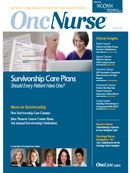Treatment Ends, but the Need for Care Continues
Celebration at the end of cancer treatment is often premature.
Shell Portner, RN, BSN
Nurse Navigator, Coordinator Cancer Survivorship Program John Muir Health Cancer Institute Walnut Creek, California
Celebration at the end of cancer treatment is often premature. For example, a newly minted survivor, having lived through the trauma of a diagnosis of breast cancer, a modified radical bilateral mastectomy, 8 rounds of dose-dense chemotherapy, and 35 days of three-field radiation cannot yet fathom how she will reenter her previous life. Fatigue, chemobrain, and pain cause further despair. On top of all this, her treatment is not actually over. Decisions remain concerning ovarian ablation, hormone therapy, and coping with the postmenopausal symptoms that will likely follow.
Hair now coming in as a fuzzy halo, GI discomfort left over from chemo, and third-degree burns developing from the inside-out over her left breast and axilla, it is with great difficulty that she smiles for the seemingly endless rounds of celebration from her caregivers on her last day of radiation treatment. Behind her brave smile are deep concerns about her low energy level, memory problems, and the possibility of recurrence. She ponders heartbreaking questions, such as, “Will I be able to play with my children as I once did?”
Survivorship care plans offer patients such as this one a detailed course of action to regain mobility, strength, and confidence. Using the recommendations of the 2005 Institute of Medicine (IOM) report From Cancer Patient to Cancer Survivor: Lost in Transition, care plans address patients’ immediate and long-term needs, facilitating their physical and psychosocial recovery.
Survivorship Care Plans in Practice
In my clinical practice setting, patients within 7 days of completing treatment are given the City of Hope Quality of Life Assessment for Cancer Survivors, which is based on the 4 domains of quality of life: Physical, Psychological, Social, and Spiritual. Patient responses are then used to create a survivorship plan. The plan includes interventions focusing on areas in which the patient is experiencing the most difficulty.
Once the plan is created, patients meet with the Survivorship Nurse Navigator for an education session. In addition to the recommendations in the IOM report, specific interventions for side effects such as fatigue, pain, concentration difficulties, sexual dysfunction, and anxiety are discussed. Regaining stamina and strength through exercise, improving sexual function, coping with depression, and overcoming fear of recurrence are just some of the commonly discussed quality-of-life issues with specific interventions and referrals our patients receive. The forum also encourages patients to ask questions that they had not considered when talking with their physicians.
“
In my clinical experience, I have observed that patients receive a tremendous benefit from having a care plan serve as a guide to recovery and continued wellness. ”
Patients are often referred by their managing care team to physical therapy, nutritional counseling, social services, and community cancer organizations for additional support. That being said, not all of our patients need this type of detail and are thus discharged from treatment accordingly.
Survivorship Study Misses Bigger Picture
As with all cancer treatment initiatives, clinical studies of survivorship care plans can provide valuable insight. However, it is important to assess the results of these studies with the proper perspective. A study presented by Grunfeld et al at ASCO 2011 suggested that survivorship care plans do not improve outcomes for patients with breast cancer. The results did not surprise me because the study involved early-stage breast cancer patients who, in my practice, often need the least intervention after treatment. Drawing a conclusion applicable to all cancer patients based on this cohort is a disservice to those patients who are experiencing the acute side effects of treatment.
In light of the ASCO study’s results, I am relieved that beginning in 2012, screening survivors for distress (Standard 3.2) and providing a treatment summary and survivorship care plan (Standard 3.3) will be the standard of care for cancer programs seeking accreditation from the Commission on Cancer of the American College of Surgeons. This will ensure that all patients get the support they need at the end of treatment.
In my experience, I have observed that patients receive a tremendous benefit from using a care plan as a guide to recovery and continued wellness. Not all patients need the interventions, but for those who do, a care plan is an essential part of their recovery after treatment.
I know this first-hand as both a Survivorship Nurse Navigator and the cancer survivor discussed above.
Looking Ahead
Please join me as we continue to discuss survivorhsip care. E-mail me your survivorship questions and examples of best practices at Shell.Portner@johnmuirhealth.com and we will do our best to provide a variety of responses from our colleagues in the field.

Innovative Program Reduces Nurse Turnover and Fosters Development
Published: September 12th 2024 | Updated: September 12th 2024The US Oncology Network (The Network) has developed one of the most comprehensive programs in the nation to support the professional development and retention of new oncology nurses.


